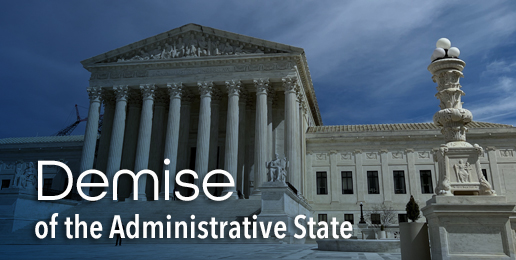
Despite the seemingly mundane nature of regulations, the U.S. Supreme Court’s recent decision to overturn Chevron Deference is poised to have a profound impact on our daily lives. This decision will touch each and every one of us, shaping our daily experiences and interactions.
While some have commented on the decision to overturn Chevron Deference, Loper Bright Enterprises v Raimondo, the focus has been largely on the decisions regarding presidential immunity and J6 defendants.
However, the reality is that the decisions on presidential immunity and J6, while significant, are not as far-reaching in scope. It is the Chevron decision that will cast the longest shadow over our country and certainly over the administrative state, a fact that should not be overlooked.
The Chevron Deference decision could be seen as a stake through the heart of the burgeoning bureaucracy. It marks the end of the era of federal agencies unilaterally redefining vague statutory language, a significant shift that the public should be aware of and understand its implications.
Essentially, Chevron incorporated the presumption that when a statute is ambiguous, Congress intended that the authority to interpret the statute belonged to the regulatory agency responsible for administering it. Under that decision, courts were directed to defer to the agency’s interpretation as long as it was reasonable, even if the court would have interpreted the statute differently.
This gave the agencies huge discretion in the interpretation and implementation of federal laws within the scope of their responsibilities.
Loper Bright Enterprises v. Raimondo marked the end of courts deferring to regulatory agencies, effectively returning the responsibility of interpreting statutes to the court, as stipulated in the Administrative Procedures Act. The decision will set a new course toward our nation’s future.
Here are some examples of why that is.
Most of the recent government actions to prevent climate change have been implemented by regulation, not statute. Agencies are redefining what the statutes mean, as did the Department of Energy by targeting popular household appliances to achieve its “net-zero energy” goals. Dishwashers and washing machines will be required to use less water, and states are being encouraged to reduce the use of gas, resulting in some states restricting or banning gas stoves.
The Department of Labor allowed, by regulation, that fiduciaries could “consider climate change and other environmental, social and governance factors (ESG) when they select retirement investments and exercise shareholder rights, such as proxy voting.”
ESG allows consideration of the desires of “stakeholders” even at the expense of shareholders.
During the COVID-19 pandemic, OSHA redefined the statutes regarding worker safety to require that all workers have COVID-19 vaccines in order to work.
No vaccine, no work.
Then, there is the massive 1,400-page rewrite of regulations by the U.S. Department of Education to implement Title IX of the Education Amendments of 1972. This revision, to be effective August 1, 2024, redefines what it means to be male and female—additionally, the regulations gut due process protections for students accused of violating provisions of the regulations.
The U.S. Supreme Court’s ruling in the Loper Bright Enterprises case most likely will result in these revisions becoming dead on delivery. Already, actions in federal courts have blocked implementation, at least temporarily, in ten states—Louisiana, Mississippi, Montana, Idaho, Indiana, Kentucky, Ohio, Tennessee, Virginia, and West Virginia.
All of these regulations mentioned here are thoroughly disconnected from the statutes behind them and essentially rewrite the laws in large parts.
The administrative state has become an immense, uncontrollable bureaucratic behemoth. In 1950, the Code of Federal Regulations consisted of 9,745 pages. By 2021, the regulations had grown to 188,321 pages in 227 volumes.
In the long term, the Loper decision should reduce the regulations, force Congress to be more specific in the statutory language it adopts, and hopefully reduce the size of the bureaucracy. In the short term, the decision will cause an increase in legal challenges throughout the country, invite greater judicial scrutiny, create delays in regulatory implementation, and trigger regulatory instability.
The decision should reduce the executive branch’s power and return more balance to the three branches of government. In the long term, it should result in greater stability. The way it is now, one administration can interpret the language of a statute one way and have that interpretation reversed by the next administration.
This has been happening in our local schools for years. Early in the Obama administration, for example, in October 2010, Russlynn Ali, Assistant Secretary for Civil Rights, U.S. Department of Education, sent a letter to every school in the country. The letter incorporated a veiled threat to every administrator that they could face enforcement action by the administration if they did not take appropriate action to end discrimination or harassment in their schools pursuant to the provisions of
“Title VI of the Civil Rights Act of 19641 (Title VI), which prohibits discrimination on the basis of race, color, or national origin; Title IX of the Education Amendments of 19722 (Title IX), which prohibits discrimination on the basis of sex; Section 504 of the Rehabilitation Act of 19733 (Section 504); and Title II of the Americans with Disabilities Act of 1990. . .”
Subsequent to issuing that letter, the Department encouraged schools to begin using material and providing programs that Department officials claimed would reduce the discrimination and harassment of students.
Much of the focus of these programs was on normalizing the LGBT lifestyle as a means of reducing bullying, discrimination, and harassment.
No attempt was made to change the regulations, which would have required public notice. Instead, the Department declared that the existing regulations required the actions it was promoting. This allowed a change of culture in our nation’s schools to occur without any notice from the general public or even the parents whose children were in the schools.
By the time the next letter came out from the Office of Civil Rights, schools were already compliant.
On May 13, 2016, toward the end of the Obama Administration, a joint letter was sent to every school from Catherine E. Lhamon, Assistant Secretary for Civil Rights, U.S. Department of Education, and Vanita Gupta, Principal Deputy Assistant Attorney General for Civil Rights, U.S. Department of Justice. The letter made very clear the Administration’s position on the proper interpretation of Title IX. Among other things, the letter stated that Title IX required:
Restrooms and Locker Rooms.
A school may provide separate facilities on the basis of sex, but must allow transgender students access to such facilities consistent with their gender identity. A school may not require transgender students to use facilities inconsistent with their gender identity or to use individual-user facilities when other students are not required to do so. A school may, however, make individual-user options available to all students who voluntarily seek additional privacy.
Athletics.
Title IX regulations permit a school to operate or sponsor sex-segregated athletics teams when selection for such teams is based upon competitive skill or when the activity involved is a contact sport. A school may not, however, adopt or adhere to requirements that rely on overly broad generalizations or stereotypes about the differences between transgender students and other students of the same sex (i.e., the same gender identity) or others’ discomfort with transgender students. Title IX does not prohibit age-appropriate, tailored requirements based on sound, current, and research-based medical knowledge about the impact of the students’ participation on the competitive fairness or physical safety of the sport.
Single-Sex Classes.
Although separating students by sex in classes and activities is generally prohibited, nonvocational elementary and secondary schools may offer nonvocational single-sex classes and extracurricular activities under certain circumstances. When offering such classes and activities, a school must allow transgender students to participate consistent with their gender identity.
Single-Sex Schools.
Title IX does not apply to the admissions policies of certain educational institutions, including nonvocational elementary and secondary schools, and private undergraduate colleges. Those schools are therefore permitted under Title IX to set their own
Social Fraternities and Sororities.
Title IX does not apply to the membership practices of social fraternities and sororities. Those organizations are therefore permitted under Title IX to set their own policies regarding the sex, including gender identity, of their members. Nothing in Title IX prohibits a fraternity from admitting transgender men or a sorority from admitting transgender women if it so chooses.
Housing and Overnight Accommodations.
Title IX allows a school to provide separate housing on the basis of sex. But a school must allow transgender students to access housing consistent with their gender identity and may not require transgender students to stay in single-occupancy accommodations or to disclose personal information when not required of other students. Nothing in Title IX prohibits a school from honoring a student’s voluntary request for single-occupancy accommodations if it so chooses.
Other Sex-Specific Activities and Rules.
Unless expressly authorized by Title IX or its implementing regulations, a school may not segregate or otherwise distinguish students on the basis of their sex, including gender identity, in any school activities or the application of any school rule. Likewise, a school may not discipline students or exclude them from participating in activities for appearing or behaving in a manner that is consistent with their gender identity or that does not conform to stereotypical notions of masculinity or femininity (e.g., in yearbook photographs, at school dances, or at graduation ceremonies).
What was done at the end of the Obama Administration was to change the meaning of Title IX without changing the regulations. Some schools started to implement these provisions before the letter was sent out since, reportedly, advance notice of the planned changes was provided long before the letter was issued.
Both before the letter and after the letter was issued, schools began to accommodate the DOEs and DOJs interpretation of Title IX by allowing transgender students to use locker rooms and bathrooms of the sex they claimed rather than their biological sex.
When the Trump Administration took over, this letter was withdrawn.
Now the Biden Administration has incorporated these provisions and many other onerous requirements into the new Title IX regulations. Which, as I said, for all practical purposes is dead on arrival.
This won’t stop state and local governments from creating similar regulations on their own. Illinois already has many. So, while the U.S. Supreme Court has removed the teeth from the federal administrative state, the massive administrative apparatus at the state and local level is alive and growing.
It would be wise to encourage people with integrity to begin taking control of local and state offices. It is vitally important that we act to reduce the size of the bureaucratic state at every level.
We have an opportunity to make a much greater impact on our local schools, libraries and other governments without the massive meddling by a multitude of federal agencies.
Christians have another chance to take back our culture.
If they are willing to engage.























